新目标七下英语教案Unit4第3课时
- 格式:doc
- 大小:72.00 KB
- 文档页数:2
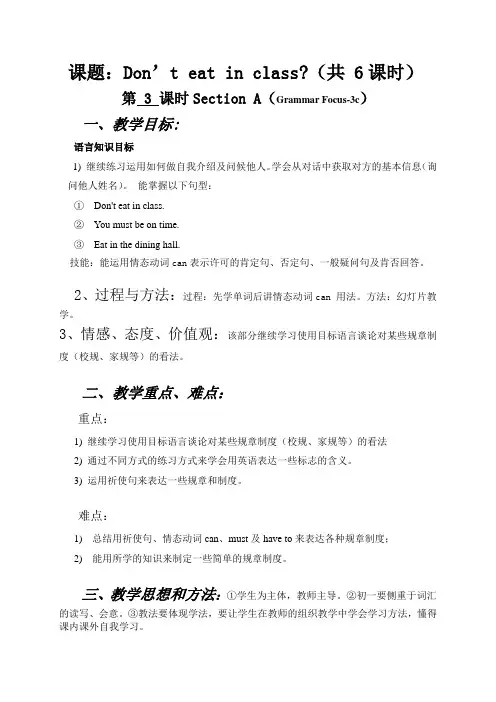
课题:Don’t eat in class?(共 6课时)第 3 课时Section A(Grammar Focus-3c)
一、教学目标:
语言知识目标
1) 继续练习运用如何做自我介绍及问候他人。
学会从对话中获取对方的基本信息(询问他人姓名)。
能掌握以下句型:
①Don't eat in class.
②You must be on time.
③Eat in the dining hall.
技能:能运用情态动词can表示许可的肯定句、否定句、一般疑问句及肯否回答。
2、过程与方法:过程:先学单词后讲情态动词can 用法。
方法:幻灯片教学。
3、情感、态度、价值观:该部分继续学习使用目标语言谈论对某些规章制度(校规、家规等)的看法。
二、教学重点、难点:
重点:
1) 继续学习使用目标语言谈论对某些规章制度(校规、家规等)的看法
2) 通过不同方式的练习方式来学会用英语表达一些标志的含义。
3) 运用祈使句来表达一些规章和制度。
难点:
1) 总结用祈使句、情态动词can、must及have to来表达各种规章制度;
2) 能用所学的知识来制定一些简单的规章制度。
三、教学思想和方法:①学生为主体,教师主导。
②初一要侧重于词汇
的读写、会意。
③教法要体现学法,要让学生在教师的组织教学中学会学习方法,懂得课内课外自我学习。
四、教学关键:如何让学生在课堂上积极主动,做到学什么就能理解、掌握和记住什么。
五、教学准备:
1、教师准备:幻灯片
2、学生准备:预习单词
六、教学过程设计。
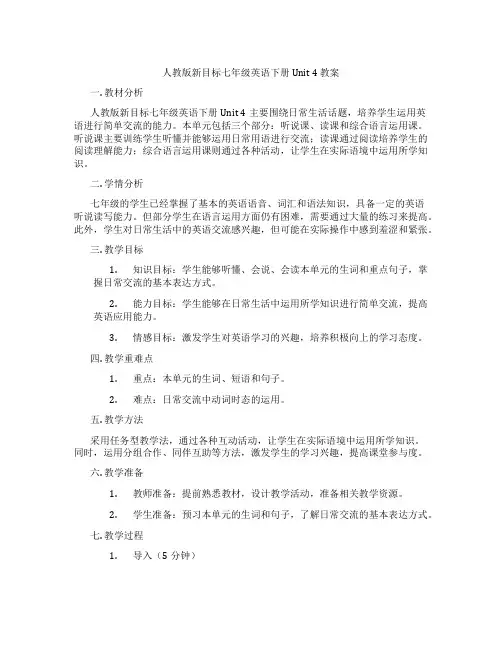
人教版新目标七年级英语下册 Unit 4 教案一. 教材分析人教版新目标七年级英语下册Unit 4主要围绕日常生活话题,培养学生运用英语进行简单交流的能力。
本单元包括三个部分:听说课、读课和综合语言运用课。
听说课主要训练学生听懂并能够运用日常用语进行交流;读课通过阅读培养学生的阅读理解能力;综合语言运用课则通过各种活动,让学生在实际语境中运用所学知识。
二. 学情分析七年级的学生已经掌握了基本的英语语音、词汇和语法知识,具备一定的英语听说读写能力。
但部分学生在语言运用方面仍有困难,需要通过大量的练习来提高。
此外,学生对日常生活中的英语交流感兴趣,但可能在实际操作中感到羞涩和紧张。
三. 教学目标1.知识目标:学生能够听懂、会说、会读本单元的生词和重点句子,掌握日常交流的基本表达方式。
2.能力目标:学生能够在日常生活中运用所学知识进行简单交流,提高英语应用能力。
3.情感目标:激发学生对英语学习的兴趣,培养积极向上的学习态度。
四. 教学重难点1.重点:本单元的生词、短语和句子。
2.难点:日常交流中动词时态的运用。
五. 教学方法采用任务型教学法,通过各种互动活动,让学生在实际语境中运用所学知识。
同时,运用分组合作、同伴互助等方法,激发学生的学习兴趣,提高课堂参与度。
六. 教学准备1.教师准备:提前熟悉教材,设计教学活动,准备相关教学资源。
2.学生准备:预习本单元的生词和句子,了解日常交流的基本表达方式。
七. 教学过程1.导入(5分钟)利用图片或实物引导学生谈论日常生活中的人物和事物,激发学生的学习兴趣。
2.呈现(10分钟)教师展示本课的生词和句子,让学生听懂并跟读。
同时,通过情景剧等形式,展示日常交流的基本表达方式。
3.操练(10分钟)学生分组进行角色扮演,模拟日常生活中的场景,运用所学知识进行交流。
教师巡回指导,纠正发音和语法错误。
4.巩固(5分钟)教师设计一些练习题,让学生口头回答,巩固所学知识。
5.拓展(5分钟)学生分组讨论,尝试用英语编写一个小故事,运用本课所学词汇和句型。
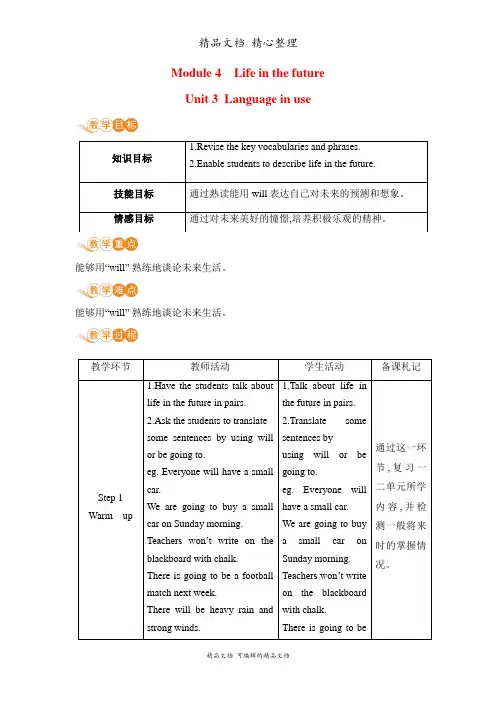
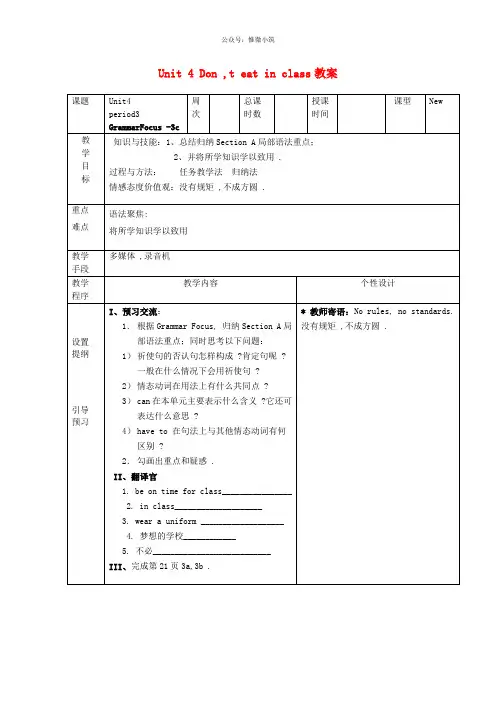
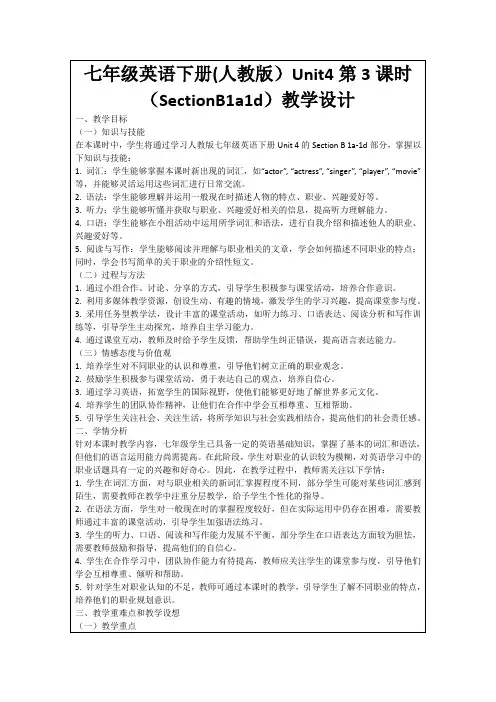

Unit 4 Don’t eat in class.Learning Objectives一、Topics(话题):Rules二、Functions (功能)Talk about rules三、Structures (结构)1. Imperatives (Don’t)2. Can for permission3. Modal verbs have to, must四、Target Language (目标语言)Don’t eat in the classroom!We ca n’t arrive late for class.We must be on time.Can we wear a hat in class?Yes, we can./No, we can’t.We have to clean the classroom.We have to follow the rules.五、V ocabulary (词汇)rule, dish, night, luck, hair, arrive, listen, fight, wear, bring, practice, relax, read, feel, remember, follow, keep, learn, quiet, noisy, dirty, terrible, strictarrive late for class, be on time, listen to music, do the dishes, make your bed, be strict with …, follow the rules六、Skills (技能)Listening for key informationScanning in reading七、Recycling (复习巩固)go out, do your homework, watch TV, clean your room, help your mom make breakfast, in the evening, every Saturday八、教材分析这本教材的词汇量很大,有难度,但是,内容新颖,尤其是生动活泼的卡通化的画面,很符合七年级学生的年龄特点和心理特点,其中还囊括了丰富多彩的文化知识,以及合作探究的活动,十分贴近学生的实际生活经验。
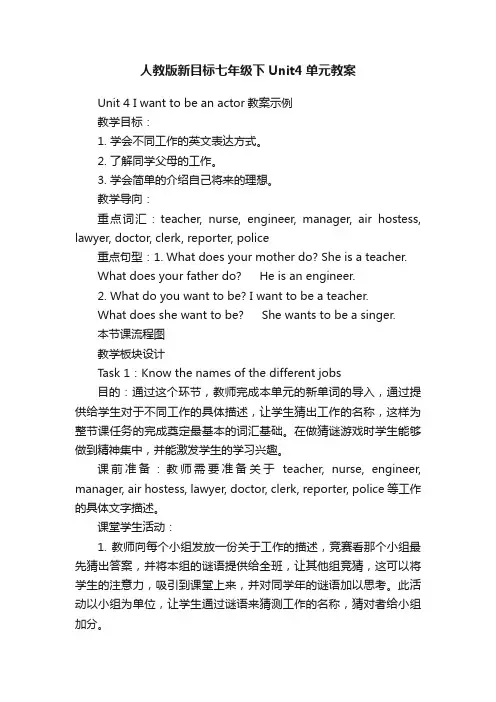
人教版新目标七年级下Unit4单元教案Unit 4 I want to be an actor教案示例教学目标:1. 学会不同工作的英文表达方式。
2. 了解同学父母的工作。
3. 学会简单的介绍自己将来的理想。
教学导向:重点词汇:teacher, nurse, engineer, manager, air hostess, lawyer, doctor, clerk, reporter, police重点句型:1. What does your mother do? She is a teacher.What does your father do? He is an engineer.2. What do you want to be? I want to be a teacher.What does she want to be? She wants to be a singer.本节课流程图教学板块设计Task 1:Know the names of the different jobs目的:通过这个环节,教师完成本单元的新单词的导入,通过提供给学生对于不同工作的具体描述,让学生猜出工作的名称,这样为整节课任务的完成奠定最基本的词汇基础。
在做猜谜游戏时学生能够做到精神集中,并能激发学生的学习兴趣。
课前准备:教师需要准备关于teacher, nurse, engineer, manager, air hostess, lawyer, doctor, clerk, reporter, police等工作的具体文字描述。
课堂学生活动:1. 教师向每个小组发放一份关于工作的描述,竞赛看那个小组最先猜出答案,并将本组的谜语提供给全班,让其他组竞猜,这可以将学生的注意力,吸引到课堂上来,并对同学年的谜语加以思考。
此活动以小组为单位,让学生通过谜语来猜测工作的名称,猜对者给小组加分。
The riddles supplied by the teacher:1) I work in the hospital every day. My work is very hard but also very important. The doctors and patients need my help. I help the doctor and look after the patients. I always wear white clothes. People call us “angels in white”.2) I drive a car every day, but the car is not mine. There are many people sitting in my car every day. After they go out of the car, they must pay me money.3) My job is very difficult but interesting. I help people on the court. If I succeed I will get lots of money, but if I fail, I get no money.4) I am very proud of my job. Because I am like your mother.I will tell you what is right and what is wrong. Sometimes I am very strict.5) I work outside; I am very busy because there are many letters in my bag, and I must give the letters to different people.6) I work in a restaurant and I always carry some fruits and dishes. I often ask people: What would you like? I am really very busy.2. 在所有单词导入后,以小组为单位,将所有单词按不同的标准分类,如:适合男人的工作,适合女人的工作等,通过这项活动,学生能将所学单词落到笔头上,同时是对所学单词的又一次巩固,而且不同的组有不同的分类原则,开发了同学无限的想象空间。
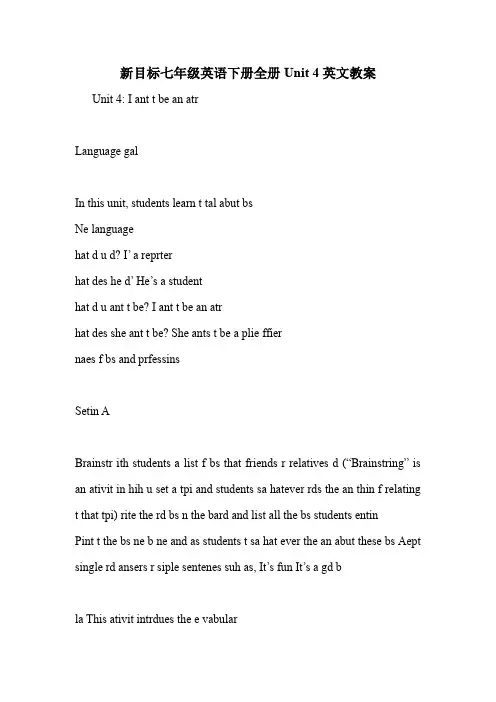
新目标七年级英语下册全册Unit 4英文教案Unit 4: I ant t be an atrLanguage galIn this unit, students learn t tal abut bsNe languagehat d u d? I’ a reprterhat des he d’ He’s a studenthat d u ant t be? I ant t be an atrhat des she ant t be? She ants t be a plie ffiernaes f bs and prfessinsSetin ABrainstr ith students a list f bs that friends r relatives d (“Brainstring” is an ativit in hih u set a tpi and students sa hatever rds the an thin f relating t that tpi) rite the rd bs n the bard and list all the bs students entinPint t the bs ne b ne and as students t sa hat ever the an abut these bs Aept single rd ansers r siple sentenes suh as, It’s fun It’s a gd bla This ativit intrdues the e vabularFus attentin n the art As students t tell hat the see in eah sene As students t nae as an f the bs shn as the an Then pint t a sene, nae the b, and as students t repeatPint t the nubered list f rds Sa eah ne and as students t repeatThen as students t ath eah rd llfa ne f the senes Sa, rite the letter f eah sene next t ne f the ivrds Pint t the saple anser1 b This ativit gives students pratie in understanding the target language in spen nversatinPint t the different peple shn in the pitureAs varius students t tell hat the d as u pint t eah ne,Sa, N u ill hear three nversatins The nversatins are abut three f the peple in this piturePla the rerding the first tie Students nl listenPla the rerding a send tie This tie as students t rite a nuber 1 next t the persn being taled abut in nversatin 1 Have students put a 2 and 3 next t the peple being taled abut in nversatins 2 and 3rret the ansers1 This ativit prvides guided ral pratie using the target language-As a student t read the exaple nversatin ith u Hld up the b and pint t the dtr in the pitureSa, N r ith ur partner ae ur n nversatins abut the piture u an use senteneslie the nes in ativit 1bSa a dialgue ith a student Pint t a piture f ne f the peple Guide the student t anser using ne f the rds in ativit 1aAs students r in pairs, ve arund the r nitring their r ner language r prnuniatin supprt as needed2a This ativit gives students pratie in understanding the target language in spen nversatinAs students t l at the three pitures As different students t tell u hat the se in eah piture hat are the peple ding? hat bs d the have?Pla the rerding the first tie Students nl listenSa, u ill hear nversatins abut the peple in these pituresPla the rerding a send tie Sa, rite the nuber f eah nversatin bel the piture f the persn being taled abutrret the ansers2b This ativit gives students pratie in understanding the target language in spen nversatinPint t the three headings in the hart and read the headings t the lass As students, hat des “ants t be” ean? (It is nt the b the persn lias n It is the b the persn ants in the future)Pla the rerding the first tie Students nl listenSa, u iU hear abut the peple in these pitures u ill hear the b the ha n and the b the ant in the futurePla the rerding a send tie This tie as students t fill in the blans ith the bs the peple have n and the nes the ant in the future Pint ut the saple2 This ativit prvides guided ral pratie using the target languagePint ut the pitures in ativit 2a As h eah persn is (The are Susan’s brther Anna’s ther, and Tn’s father)Sa, N r ith ur partner As and anser questins abut the pitures As, “hat des he r she d?” Then as, “hat des he r she ant t be?”Sa a dialgue ith a student Pint t Anna’s ther and then t the exaple in the speeh ballns Pratie the dialgue ith a studentAs students r In pairs, ve arund the r nitring their r ffer language supprt as needed3a This ativit intrdues the naes fr the plaes here peple r, and gives reading pratie using the target languageall attentin t the pitures As students t read the nae fr eah plae As the nae eah plae, rite the rd n the bard and-as the lass t repeat itPint ut the list f bs ith the nubers next t eah Then all attentin t the peple in the pitures and the speeh bubbles Pint ut the saple anser and have a student read ut the speeh bubbleAs students t r alne Sa, rite the nuber f eah b in the square next t eah rplae he the ansers3b This ativit prvides guided ral pratie using the target languagePint ut the pitures in ativit 3a As students t nae the rplae shn In eah pitureThen pint ut the nversatin in the speeh bubbles As t students t read It t the lassSa, r ith a partner First pratie the nversatin in the piture Then ae ne nversatins Use bs and plaes fr ativit 3aSa a dialgue ith a student Pint t the rd aiter in ativit 3a and then t the piture f the restaurant As a student here des he r? Guide the student t anser using the rret plae: He rs in a restaurantThen as hat des he d? and guide the student t anser, He’s a aiterAs students r in pairs, ve arund the r nitring their r ffer language supprt as needed4 This ativit prvides listening and speaing pratie using the target language all attentin t the pitures in the b shing h t pla the gae Sa, u ill dra a piture f sene ring ther students ill as questins abut the ind f b u are draing After t questins sene an tr t guess the bDenstrate b draing a piture n the bard f a sti figure reprter Add details (irphne, nteb,et) until students guess hat b it isAs a student t g t the bard Sa, Dra a piture f a persn ring If neessar, help the student add details that sh the b the persn is ding He r she an add a ban interir t sh that the persn is a ban ler A student uld als use an ee hart n the all t sh that the plae is a dtr’s ffie and the persn is a dtrAs t different students t as questins abut the b, and then as a third student t guess hat b it isPla the gae using draings b several different studentsAlternative: If u d nt ant students t ve fr their seats, then u an as the t d this ativit sitting dn in grups f fur The ill need piees f paper n hih t dra their pitures The ill als need penilsSetin BNe languagerds that desribe bs, suh as exiting, dangerus,bring, diffiult, bus, fun Additinal aterials t bring t lass:help anted ads fr an English-language nespaper1 a This ativit intrdues the e vabularFus attentin n the six pitures As, hat b des the persn have? here des the persn ivnr?Pint ut the nubered list f rds Sa eah ne and as students t repeat Then use siple explanatins and shrt saple sentenes t help students understand hat eah rd eans Fr exaple, Exiting eans ver interesting and ver fast-ving A plie ffier has an exiting b The b is alas hanging Sething is alas happening Fr dangerus u ight sa, Dangerus eans nt safe u ight be hurt r illed in a dangerus bThen as students t ath eah rd ith ne f the pitures Sa, rite the letter f eahpiture next t ne f the rds Pint ut the saple anserhe the ansers1 b This ativit prvides guided ral pratie using the target languageall attentin t the piture In this ativit and as a student t read the stateent t the lass Then pint t the piture f the plie ffier and sa It’s an exiting b As the lass t repeat Then sa, hat else an u sa abut being a plie ffier? Sene a anser, It’s a dangerus b As the lass t repeat eah rret anserThen as students t r in pairs Suggest that the eah pint t the pitures f the rers and ae stateents abut the As students pratie, ve arund the lassr nitring their r1 This ativit prvides an pprtunit fr ral pratieSa, Nae se f the bs fr this unit rite this list f bs n the bard Sa, an u nae se ther bs? Add an ne bs t the listAs se students t ae stateents abut bs n the list using the rds in ativit la u a ish t rite se f the sentenes n the bard s that students an p the sentenes int their ntebs2a This ativit prvides listening and riting pratie ith the target languageall attentin t the t headings and as a student t read die headings t the lass Pint ut the blan lines here students ill rite the nae f a b (under the rds ants t be)Pla Ihe rerding the first tie Students nl listenSa, N I ill pla the tape again This tie rite the nae f a b under the rds “ants tbe”2b This ativit prvides listening and riting pratie ith the target language,all attentin t the send heading and as a student t read it t the lass Sa, This tie u ill unite h eah persn ants the bPla the rerding again Students nl listenThen sa, N I ill pla the tape again This tie rite the reasn the persn ants the b under the rd “h?”Pla the rerding Students rite their ansershe the ansers2 This ativit prvides pen-ended ral pratie using the target languageSa, hat d u ant t be? hat rds desribe eah b? Help the lass ae up a list f bs the ight lie t d As students suggest pssible bs, as the lass t suggest rds t desribe the Use a bilingual ditinar, if neessar, t find the naes f bs and rds t desribe eah neThen as students t r in sall grups The tell eah ther hat the ant t d and h Enurage students t use ditinaries if neessar ve fr grup t grup ffering assistane as neededAs individual students t tell the lass abut hat the ant t be and h3a This ativit prvides reading and riting pratie using the target language all attentin t the three nespaper ads and read these ads t the lass Sa blan eah tie u e t a blan lineThen read eah ad again separatel, pausing t all students t as questins abutanthing the dn’t understand Fr exaple, in the first ad, students a nt n that ring late eans “ring at night” T r hard eans t use a lt f energ t d the bAs students t fill In (he blans in the ads using the rds atr, reprter, and aiter he the ansers3b This ativit prvides reading and riting pratie using the target language all attentin t the nespaper ad and as a student t read it, saing blan fr eah blan lineAs students t fill in the blans using rds fr This setin Sa,L at the pitures next t eah blan line The pitures ill help u guess the rret rdSuggest that the l at the naes f bs and the rds that desribe bs in the first part f Setin Bhe the ansers,3 This ativit prvides riting pratie using the targetlanguagePint ut the blan strip f nespae need a plie ffierall the Sithtn Plie Statin at -2323As students t read their ads t a partner As the pairs t rret eah ther’s r4 This ativit prvides guided ral pratie using thetarget languageAs t students t read the nversatin in the speeh bubbles Anser an questins students a have abut itThen sa, Ne please r in grups As efuestins t find ut hat bs eah persn rte abut u an use sentenes lie the nes e ust readAs students as questins, ve fr grup t grup Rephrase an inplete r inrret questinsAls rephrase an inaurate ansers。
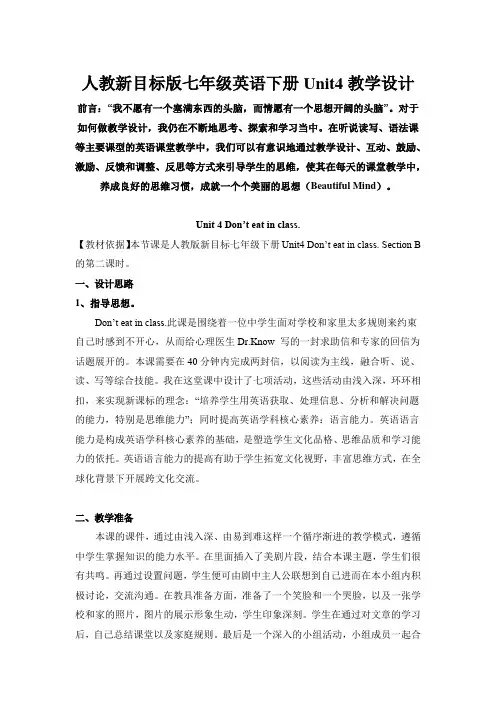
人教新目标版七年级英语下册Unit4教学设计前言:“我不愿有一个塞满东西的头脑,而情愿有一个思想开阔的头脑”。
对于如何做教学设计,我仍在不断地思考、探索和学习当中。
在听说读写、语法课等主要课型的英语课堂教学中,我们可以有意识地通过教学设计、互动、鼓励、激励、反馈和调整、反思等方式来引导学生的思维,使其在每天的课堂教学中,养成良好的思维习惯,成就一个个美丽的思想(Beautiful Mind)。
Unit 4 Don’t eat in class.【教材依据】本节课是人教版新目标七年级下册Unit4 Don’t eat in class. Section B 的第二课时。
一、设计思路1、指导思想。
Don’t eat in class.此课是围绕着一位中学生面对学校和家里太多规则来约束自己时感到不开心,从而给心理医生Dr.Know 写的一封求助信和专家的回信为话题展开的。
本课需要在40分钟内完成两封信,以阅读为主线,融合听、说、读、写等综合技能。
我在这堂课中设计了七项活动,这些活动由浅入深,环环相扣,来实现新课标的理念:“培养学生用英语获取、处理信息、分析和解决问题的能力,特别是思维能力”;同时提高英语学科核心素养:语言能力。
英语语言能力是构成英语学科核心素养的基础,是塑造学生文化品格、思维品质和学习能力的依托。
英语语言能力的提高有助于学生拓宽文化视野,丰富思维方式,在全球化背景下开展跨文化交流。
二、教学准备本课的课件,通过由浅入深、由易到难这样一个循序渐进的教学模式,遵循中学生掌握知识的能力水平。
在里面插入了美剧片段,结合本课主题,学生们很有共鸣。
再通过设置问题,学生便可由剧中主人公联想到自己进而在本小组内积极讨论,交流沟通。
在教具准备方面,准备了一个笑脸和一个哭脸,以及一张学校和家的照片,图片的展示形象生动,学生印象深刻。
学生在通过对文章的学习后,自己总结课堂以及家庭规则。
最后是一个深入的小组活动,小组成员一起合作自制一张关于规则的海报Anchor Chart (锚图),即常用的一种帮助学生归纳要点、整理思维的示意图。
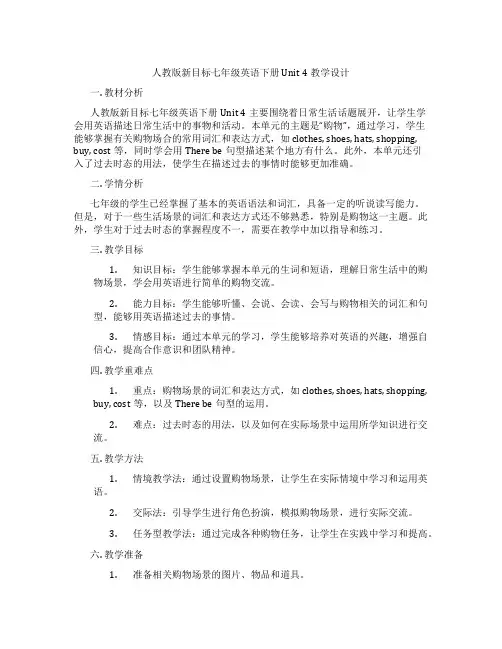
人教版新目标七年级英语下册 Unit 4教学设计一. 教材分析人教版新目标七年级英语下册Unit 4主要围绕着日常生活话题展开,让学生学会用英语描述日常生活中的事物和活动。
本单元的主题是“购物”,通过学习,学生能够掌握有关购物场合的常用词汇和表达方式,如clothes, shoes, hats, shopping, buy, cost等,同时学会用There be句型描述某个地方有什么。
此外,本单元还引入了过去时态的用法,使学生在描述过去的事情时能够更加准确。
二. 学情分析七年级的学生已经掌握了基本的英语语法和词汇,具备一定的听说读写能力。
但是,对于一些生活场景的词汇和表达方式还不够熟悉,特别是购物这一主题。
此外,学生对于过去时态的掌握程度不一,需要在教学中加以指导和练习。
三. 教学目标1.知识目标:学生能够掌握本单元的生词和短语,理解日常生活中的购物场景,学会用英语进行简单的购物交流。
2.能力目标:学生能够听懂、会说、会读、会写与购物相关的词汇和句型,能够用英语描述过去的事情。
3.情感目标:通过本单元的学习,学生能够培养对英语的兴趣,增强自信心,提高合作意识和团队精神。
四. 教学重难点1.重点:购物场景的词汇和表达方式,如clothes, shoes, hats, shopping,buy, cost等,以及There be句型的运用。
2.难点:过去时态的用法,以及如何在实际场景中运用所学知识进行交流。
五. 教学方法1.情境教学法:通过设置购物场景,让学生在实际情境中学习和运用英语。
2.交际法:引导学生进行角色扮演,模拟购物场景,进行实际交流。
3.任务型教学法:通过完成各种购物任务,让学生在实践中学习和提高。
六. 教学准备1.准备相关购物场景的图片、物品和道具。
2.准备本单元的生词和短语卡片。
3.准备录音机、磁带或音频文件,用于听力训练。
4.准备课件和教案。
七. 教学过程1.导入(5分钟)利用图片和物品,引入购物话题,激发学生的兴趣。
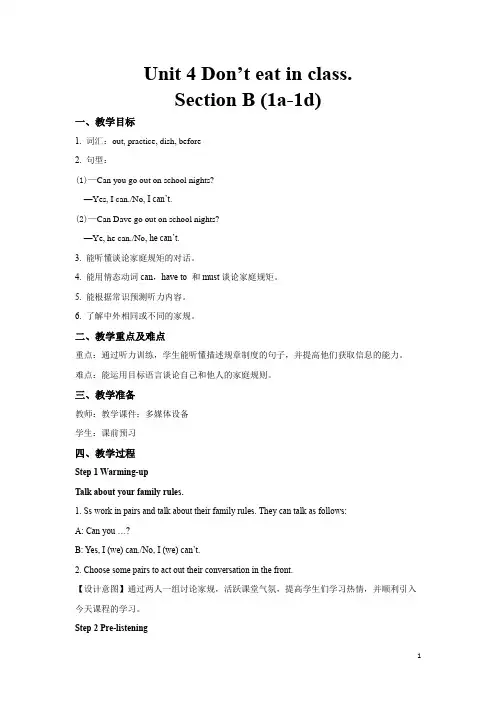
Unit 4 Don’t eat in class.Section B (1a-1d)一、教学目标1. 词汇:out, practice, dish, before2. 句型:(1)—Can you go out on school nights?—Yes, I can./No, I can’t.(2)—Can Dave go out on school nights?—Ye, he can./No, he can’t.3. 能听懂谈论家庭规矩的对话。
4. 能用情态动词can,have to 和must谈论家庭规矩。
5. 能根据常识预测听力内容。
6. 了解中外相同或不同的家规。
二、教学重点及难点重点:通过听力训练,学生能听懂描述规章制度的句子,并提高他们获取信息的能力。
难点:能运用目标语言谈论自己和他人的家庭规则。
三、教学准备教师:教学课件;多媒体设备学生:课前预习四、教学过程Step 1 Warming-upTalk about your family rules.1. Ss work in pairs and talk about their family rules. They can talk as follows:A: Can you …?B: Yes, I (we) can./No, I (we) can’t.2. Choose some pairs to act out their conversation in the front.【设计意图】通过两人一组讨论家规,活跃课堂气氛,提高学生们学习热情,并顺利引入今天课程的学习。
Step 2 Pre-listeningWords and expressions1. T leads Ss to read the new words and expressions.2. Ss read them individually.3. T asks some Ss to read the new words and expressions, and check their pronunciation.【设计意图】让学生熟悉新词汇,为后面的学习做铺垫。
Unit 4 I want to be an actor SectionA(1a-1b-1c) 1,Background information:Students : 40 junior high school students, Grade1 Material: text book Lesson duration:40 mins Type of lesson: listening and speaking lesson 2,Teaching objectives: By the end of the lesson, students should: 1) Language aims (shop assistant, doctor, reporter, (1)be able to master the new words policeman, waiter, bank clerk). (What do you do? I'm a .... (2)be able to use the sentense structure What does he/she do. He/she's a….What do you want to be? to talk about job. I want to be an actor .) (2) Ability aims (1)be able to communicate with others about the job,improve their communicative skill. (2) be able to simply describe their ideal job and communicate with others about their ideal job,develop their expressive skill. 3) Emotional aims (1) respect other people’s job . (2) make a right decision of their own career in the future . (3) try their best to realize their dream. SectionA (1a -1b-1c )3, Teaching contents: S ectionA (1a -1b-1c )Step1:Warming-up(3mins)(1)Greeting!(2)Ask student to guess the job of the person on the picture and ask them some questions to check their preview-work before the class. Step 2:Target-language studying (PPT .(6mins) (6)Use some pictures of Chenglong to ask students some questions, What do you want to be?---I want to and then lead up the sentence (be a/an…)(T:Do you know this man ?S:Yes! T ;Who is he? S1:He is Chenglong. T:So,what dose he do? S3:He is an actor.T:Do you like him ,Do you want to be an actor like him…What do you want to be ?).(3mins)According to this lesson,According to this lesson,on the one hand on the one hand , students shoud master the new words of jods(shop assistant, doctor, reporter, policeman, waiter, bank clerk )and the new )and the new strctures What do you do? I'm a ....What does he/she do. He/she He/she's a…What do you want to be? 's a…What do you want to be? I want to be a/an … .; on the other hand, they should be able to talk about their own ideal job ,about their own ideal job ,what what ’s more ,all students should realize : it is neccesary for us to respect other people people’’s job.8, Homework:Make a survey about your family members job and their ideal job .9, Optional activities:。
初一年级英语下册教学计划:Unit 4 第三课时大家把理论知识学习好的同时,也应该要复习,从复习中找到自己的不足,下面是初中频道为大家整理的初一年级英语下册教学计划,希望对大家有帮助。
I.教材分析: Language topic: What do you want to be? Why do you want to be ---? Because it is -------. Language strategies: describe jobs. Main vocabulary: exciting busy, dangerous, difficult, fun, boring II.语言结构:Why do you want to be a ---? Because it is --------. III.语言功能:表达对不同职业的看法。
IV. Teaching steps: Step 1:Greetings. Step 2: Practise dialogue like this: (1) Show a picture (picture one on page 22) T: What does the man do? S: He is a police officer. T: It’s an exciting job,isn’t it? S: Yes, I think so. ( I think it is dangerous.) Ask the students to tell what they think of police officer. (2) show the second picture of a doctor。
Unit 4 Don’t eat in class.Part 1: Teaching Design (第一部分:教学设计)Unit goals●Learn to use “can”●Talk about rules.Vocabulary New wordsClassroom, fright, rule, outside, dining, else, wash, letter, children,palace,loudlyNew Phraseshave to, sports shoes, Children’s Palace,arrive late, in the hallways, on school nightsExpressions Don’t eat in class.Don’t listen to music in the classroom or the hallways.You have to wear sports shoes for gym class.Can students eat in classroom?Practice your guitar every day.No talking.Structures What are the rules at your school?Don’t run in the hallways and don’t arrive late for class.Can we eat in school?We can eat in the dining hall. But we can’t eat in the classrooms.Can you hear hats in school?Yes, we can. No, we can’t.What else do you have to do?We have to clean the classroomSection ATeaching goals●Master the new words: Ms, hallway, classroom, fight, rule, outside, else, have to, sports shoes, gym●Learn to talk about rulesWhat are the rules in your school / class?Don’t eat in class.Listen carefully in class.We have to wear uniforms in school.We can’t run in the hallways.Teaching proceduresStep 1: Warming up1.Ask students what they usually do in school / in class / after school/ after class/ at home/ on weekends2.Ask students what they can do.Model: T: Can you sing?S: Yes, I can.T: Can you sing in class?S: No, I can’t.T: Can you eat in class?S: No, we can’t.Step 2: Presenting1.Stud ents work in pairs, ask and answer about what they can do and can’t do in school.2.Show a card of school rules. Ask students say these are our school rules.Ask students: What are the school rules? Help students to translate some rules in English. For example:Don’t arrive late for class.Don’t run in the hallways.Don’t listen to music in class.Don’t fight with others.Don’t talk loudly in class.We have to finish your homework on time.We have to wear school uniforms on Monday.Listen carefully in class.No talking in the library.3.Let students read the rules loudly.Step 3: PracticingActivity 1Ask students to say out their school rules or class rules as many as possible.Activity 2Ask students to tell their family rules to the class.For example: I have to get home before 6pm.Don’t watch TV too late.Wash my clothes by myself.Finish my homework.Activity 3 (1a)1.Focus students’ attention to the picture in 1a. Ask students:What are the students doing in the picture?Is that good for the team to do that?What do you want to say to them?Help students answer. For example:Don’t eat in class.Don’t listen to music in class.2.Focus attention on the five rules written under “school rules”. Let students read all the rules aloud and help them know their meanings.3.Students work individually. Which rules are these students breaking? Write the number of the rule next to the student.4.Check the answers. P711.boy looking at his watch2.boy running in the hallway3.girl eating an apple4.boy with headphones5.boys sitting at desks, fightingStep 4: Listening (1b)1.Point to the instructions and names in 1b. Read it to the class. Ask students to listen carefully. Pay attention to what rules these students are breaking.2.Play the recording the first time. Students listen and write the numbers after the names.TapescriptMs Clark: Hey, Peter. You know the rules. Don’t run in the hallways.Peter: Sorry, Ms Clark.Mr Smith: Selina, don’t eat in class.Nick: Oh, sorry, Mr Smith.Mr Smith: Hey, Nick. Don’t listen to music in class, Nick.Boy 1: He can’t hear you, Mr Smith.3.Check the answers.Peter:2 Selina: 3 Nick: 44.Students listen again and repeat.Step 5: Listening (2a,2b)1.Point to the rules in the chart in 2a. Let students read them aloud.2.Play the reading the first time. Students listen and check the activities Alex and Cindy talk about.TapescriptCindy: What are the school rules, Alex?Alex: Well, we can’t listen to music in the classrooms or hallways. But we can listen to it in the music room.Cindy: Uh-huh.Alex: And we can’t eat in the classrooms, but we can eat in the dining hall.Cindy: Oh. And can we wear a hat in class?Alex: No, we can’t wear hats. What else? Oh, you can’t fight with anyone. That makes the teachers really unhappy.Cindy: I see ...3.Check the answers: These items are checked: 1 2 3 5 6 74.Play the recording the second time. Students listen and pay attention to these activities Alex and Cindy can do or can’t do. Circle “can” or “can’t” in the form.5.Check the answers.Can: 6. listen to music in the music room7. eat in the dining hallCan’t: 1. listen to music in the hallways2. eat in the classrooms3. wear a ha4. fight6. Students work in pairs. Student A is Alex, and Student B is Cindy. Ask and answer about the school rules.For example: Cindy: Can we listen to music, Alex?Alex: We can’t listen to music in the hallways, but we can listen to it outside.Cindy: Can we eat in the classroom?Alex: No, we can’t.7. Check some pairs.Step 6: PracticingActivity 11.Ask students to look at the three pictures in 3a. Teacher reads the speech bubbles. Call their attention to the blanks.2.Point to the three words. Let students read together.3.Ask students to work individually. Fill in the blanks with the correct words in the box.4.Check the answers. P73Activity 21. Students work in pairs, ask and answer question about the rules at their school, using “have to”.Model: A: Do we have to wear a uniform?B: Yes, we do.A: Do we have to come to school on time?B: Yes, we do.2. Ask some pairs to act out.Activity 31. Students take out a piece of paper and write down some school rules. Then make new school rules or class rules.Section BTeaching goals●Master the new words: wash, later, children, palace, Children’s Palace, loudly●Learn to use new sentences: Don’t go out on school nights.I have to be in bed by ten o’clock.I have to go to the children’s Palace to learn the piano.No talking.Teaching proceduresStep 1: Making a revisionActivity 11. Students work in fours. Three students do some activities they can’t do in class. The fourth student acts as a teacher to stop them.2. Ask some groups to act out in class.Activity 2Show students some pictures about traffic signs. Ask them what these sings mean. For example: Don’t stop your car here.Be careful.Turn left.Drive slowly.Step 2: PracticingActivity 11.Focus attention on the four pictures in Part 1. ask students to tell what they see in each picture by answering what the boy is dong in each picture.2.Point to the four rules in the chart. Students read them aloud.3.Ask students to match the pictures a—d with the rules.4.Check the answers.The rules should be lettered in this order: d a b cStep 3: Listening1.Point to the instruction in 2a. Let students listen to a conversation between Dave and Emily carefully.TapescriptDave: Can you go to the movies tonight, Emily?Emily: No, I can’t. I can’t go out on school nights.Dave: Oh, that’s too bad. I can go out, but I have to be home by ten o’clock.Emily: You’re lucky. I have so many rules ...Dave: Like what?Emily: I can’t hang out with my friends after school.Dave: Really?Emily: Yeah, I have to do my homework after school.Dave: Oh, I do, too. And I have to practice my guitar every day.Emily: Well, I have to clean my room every weekend.Dave: Ugh.Emily: And I can’t watch TV after school.Dave: I ca n’t, either.2.Play the recording the first time, students listen and number the rules 1—4 in the order they hear.3.Check the answers: The rules should be numbered in this order: 4 1 2 34.Play the recording the second time, students listen and pay attention to the rules Emily and Dave have and put checks under Emily or Dave.5.Check the answers.Dave’s rules: Don’t watch TV after school.Do his homework after school.Practice his guitar every day.Emily’s rules: Don’t watch TV after s choolDon’t go out on school night.Do her homework after school.6.Students listen to the tape once more and repeat.7.Students work in pairs and talk about the rules in their house. For example:S1: I have to do my homework after school, and I ....S2: I can’t go out on school night, and I ....Step 4: Reading (3a)1.Call attention to the letter. Draw students’ attention to the form of an English letter.2.Read the letter to the class or ask a student to do this. Explain some words and expressions that students d on’t understand.3.Ask students to work alone and write the list of rules on Zhao Pei’s house.4.Check the answers.1)get up at six o’clock2)don’t meet her friends after school3)has to do her homework after school.4)can’t watch TV on school nights5)has to be in bed by ten o’clock6)has to clean her room and wash her clothes on weekends7)has to help her mom make dinner8)has to learn the piano5.Let students talk about Zhao Pei’s rules by asking and answering:What can she do?What can’t she do?Does she have to ...?Step 5: Writing (3b)Activity 11.Point to the five pictures in 3b. Let students guess what each picture means.2.Let students write the library rules in the chart.3.Check the answers.1.No talking.2.No school bags.3.No food.4.No wet umbrellas.5.No listening to music.4.Ask students to read the rules aloud.Activity 2Ask students to draw some signs of any other rules. Let other students guess what these sings mean.Activity 31.Ask students to write their own family rule alone.2.Ask some individual students read their family rules to the class.Self-checkTeaching goals●Help students to review all the key vocabulary presented in this unit.●Help students practice writing about others.●Give students an opportunity to use the target language in conversation.Teaching ProceduresStep 1:Learn words1.Ask students to read the words aloud in Part 1 and know the meanings of them.2.Ask students to divide the words into 3 different groups.1)verbs: arrive, go out, practice, can, can’t, have to, listen2)nouns: classroom, hallway, uniform, sports shoes,3)others: late, outside, without3.Let students write five or more new words in their vocab-builder.Step 2: Writing1.Call attention to the pictures in Part 3. Let students tell what they can see in each picture.2.Students work alone. List the rules of the Fraser Family,3.Check the answers4.S1 reads the rules aloud.5.Let students imagine they are children in the Fraser family. Write a letter alone to Dr Know about the rules in their house.6.Ask some individual students to read their family rules to the class.。
新目标七年级英语下册全册Unit 4英文教案Unit4:Iwanttobeanactor.LanguagegoalInthisunit,studentslearntotalkaboutjobs.Newlanguagewhatdoyoudo?I'mareporterwhatdoeshedo.'He'sastudent.whatdoyouwanttobe?Iwanttobeanactor.whatdoesshewanttobe?Shewantstobeapoliceofficer namesofjobsandprofessionsSectionABrainstormwithstudentsalistofjobsthatfriendsorrelat ivesdo.writethewordjobsontheboardandlistallthejobss tudentsmention.Pointtothejobsonebyoneandaskstudentstosaywhateverth eycanaboutthesejobs.Acceptsinglewordanswersorsimple sentencessuchas,It'sfun.It'sagoodjob.laThisactivityintroducesthekeyvocabulary.Focusattentionontheart.Askstudentstotellwhattheysee ineachscene.Askstudentstonameasmanyofthejobsshownas theycan.Thenpointtoascene,namethejob,andaskstudents torepeat.Pointtothenumberedlistofwords.Sayeachoneandaskstude ntstorepeat.Thenaskstudentstomatcheachwordwllfaoneofthescenes.S ay,writetheletterofeachscenenexttooneoftheivords.Po inttothesampleanswer.1bThisactivitygivesstudentspracticeinunderstandingthe targetlanguageinspokenconversation.Pointtothedifferentpeopleshowninthepicture.Askvario usstudentstotellwhattheydoasyoupointtoeachone,Say,Nowyouwillhearthreeconversations.Theconversatio nsareaboutthreeofthepeopleinthispicture.Playtherecordingthefirsttime.Studentsonlylisten.Playtherecordingasecondtime.Thistimeaskstudentstowr iteanumber1nexttothepersonbeingtalkedaboutinconvers ation1.Havestudentsputa2and3nexttothepeoplebeingtal kedaboutinconversations2and3.correcttheanswers.cThisactivityprovidesguidedoralpracticeusingthetarge tlanguage-Askastudenttoreadtheexampleconversationwithyou.Hold upthebookandpointtothedoctorinthepicture.Say,Nowworkwithyourpartner.makeyourownconversations aboutthepicture.youcanusesentencesliketheonesinacti vity1b.Sayadialoguewithastudent.Pointtoapictureofoneofthep eople.Guidethestudenttoanswerusingoneofthewordsinac tivity1a.Asstudentsworkinpairs,movearoundtheroommonitoringth eirwork.onerlanguageorpronunciationsupportasneeded.2aThisactivitygivesstudentspracticeinunderstandingthe targetlanguageinspokenconversation.Askstudentstolookatthethreepictures.Askdifferentstu dentstotellyouwhattheysecineachpicture.whatarethepe opledoing?whatjobsdotheyhave?Playtherecordingthefirsttime.Studentsonlylisten.Say ,youwillhearconversationsaboutthepeopleinthesepictu res.Playtherecordingasecondtime.Say,writethenumberofeac hconversationbelowthepictureofthepersonbeingtalkeda bout.correcttheanswers.2bThisactivitygivesstudentspracticeinunderstandingthe targetlanguageinspokenconversation.Pointtothethreeheadingsinthechartandreadtheheadings totheclass.Askstudents,whatdoes"wantstobe"mean?Playtherecordingthefirsttime.Studentsonlylisten.Say ,youwiUhearaboutthepeopleinthesepictures.youwillhea rthejobtheyhawnowandthejobtheywantinthefuture.Playtherecordingasecondtime.Thistimeaskstudentstofi llintheblankswiththejobsthepeoplehavenowandtheonest heywantinthefuture.Pointoutthesample2cThisactivityprovidesguidedoralpracticeusingthetarge tlanguage.Pointoutthepicturesinactivity2a.Askwhoeachpersonis.Say,Nowworkwithyourpartner.Askandanswerquestionsabo utthepictures.Ask,"whatdoesheorshedo?"Thenask,"whatdoesheorshewanttobe?"Sayadialoguewithastudent.PointtoAnna'smotherandthen totheexampleinthespeechballoons.Practicethedialogue withastudent.AsstudentsworkInpairs,movearoundtheroommonitoringth eirwork.offerlanguagesupportasneeded.3aThisactivityintroducesthenamesfortheplaceswherepeop lework,andgivesreadingpracticeusingthetargetlanguag e.callattentiontothepictures.Askstudentstoreadthename foreachplace.Astheynameeachplace,writethewordontheb oardand-asktheclasstorepeatit.Pointoutthelistofjobswiththenumbersnexttoeach.Thenc allattentiontothepeopleinthepicturesandthespeechbub bles.Pointoutthesampleanswerandhaveastudentreadoutt hespeechbubble.Askstudentstoworkalone.Say,writethenumberofeachjobi nthesquarenexttoeachworkplace.checktheanswers.3bThisactivityprovidesguidedoralpracticeusingthetarge tlanguage.Pointoutthepicturesinactivity3a.Askstudentstonameth eworkplaceshownIneachpicture.Thenpointouttheconversationinthespeechbubbles.Asktw ostudentstoreadIttotheclass.Say,wowworkwithapartner.Firstpracticetheconversatio ejobsandpl acesfromactivity3a.Sayadialoguewithastudent.Pointtothewordwaiterinacti vity3aandthentothepictureoftherestaurant.Askastuden t.wheredoeshework?Guidethestudenttoanswerusingthecorrectplace:Heworksinarestaurant.Thenask.whatdoeshed o?andguidethestudenttoanswer,He'sawaiter.Asstudentsworkinpairs,movearoundtheroommonitoringth eirwork.offerlanguagesupportasneeded.4Thisactivityprovideslisteningandspeakingpracticeusi ngthetargetlanguage.callattentiontothepicturesinthebookshowinghowtoplay thegame.Say,youwilldrawapictureofsomeoneworking.oth erstudentswillaskquestionsaboutthekindofjobyouaredr awing.Aftertwoquestionssomeonecantrytoguessthejob.Demonstratebydrawingapictureontheboardofastickfigur ereporter.Adddetailsuntilstudentsguesswhatjobitis.Askastudenttogototheboard.Say,Drawapictureofaperson working.Ifnecessary,helpthestudentadddetailsthatsho wthejobthepersonisdoing.Heorshecanaddabankinteriort oshowthatthepersonisabankclerk.Astudentcouldalsouseaneyechartonthewalltoshowthattheplaceisadoctor'soff iceandthepersonisadoctor.Asktwodifferentstudentstoaskquestionsaboutthejob,an dthenaskathirdstudenttoguesswhatjobitis.Playthegameusingdrawingsbyseveraldifferentstudents.Alternative:Ifyoudonotwantstudentstomovefromtheirse ats,thenyoucanaskthemtodothisactivitysittingdowning roupsoffour.Theywillneedpiecesofpaperonwhichtodrawt heirpictures.Theywillalsoneedpencils.SectionBNewlanguagewordsthatdescribejobs,suchasexciting,dangerous,bori ng,difficult,busy,funAdditionalmaterialstobringtoclass:helpwantedadsfromanEnglish-languagenewspaper1aThisactivityintroducesthekeyvocabulary.Focusattentiononthesixpictures.Ask,whatjobdoesthepe rsonhave?wheredoesthepersonivnrk?Pointoutthenumberedlistofwords.Sayeachoneandaskstud entstorepeat.Thenusesimpleexplanationsandshortsampl esentencestohelpstudentsunderstandwhateachwordmeans .Forexample,Excitingmeansveryinterestingandveryfast -moving.Apoliceofficerhasanexcitingjob.Thejobisalwa yschanging.Somethingisalwayshappening.Fordangerousy oumightsay,Dangerousmeansnotsafe.youmightbehurtorki lledinadangerousjob.Thenaskstudentstomatcheachwordwithoneofthepictures. Say,writetheletterofeachpicturenexttooneofthewords. Pointoutthesampleanswer.checktheanswers.bThisactivityprovidesguidedoralpracticeusingthetarge tlanguage.callattentiontothepictureInthisactivityandaskastudenttoreadthestatementtotheclass.Thenpointtothepictur eofthepoliceofficerandsay.It'sanexcitingjob.Askthec lasstorepeat.Thensay,whatelsecanyousayaboutbeingapo liceofficer?Someonemayanswer,It'sadangerousjob.Askt heclasstorepeateachcorrectanswer.Thenaskstudentstoworkinpairs.Suggestthattheyeachpoi nttothepicturesoftheworkersandmakestatementsaboutth em.Asstudentspractice,movearoundtheclassroommonitor ingtheirwork.cThisactivityprovidesanopportunityfororalpractice.Say,Namesomeofthejobsfromthisunit.writethislistofjo bsontheboard.Say,canyounamesomeotherjobs?Addanynewj obstothelist.Asksomestudentstomakestatementsaboutjobsonthelistus ingthewordsinactivityla.youmaywishtowritesomeofthes entencesontheboardsothatstudentscancopythesentences intotheirnotebooks.2aThisactivityprovideslisteningandwritingpracticewith thetargetlanguage.callattentiontothetwoheadingsandaskastudenttoreaddi eheadingstotheclass.Pointouttheblanklineswherestudentswillwritethenameo fajob.PlayIherecordingthefirsttime.Studentsonlylisten.Say,NowIwillplaythetapeagain.Thistimewritethenameof ajobunderthewords"wantstobe."2bThisactivityprovideslisteningandwritingpracticewith thetargetlanguage,callattentiontothesecondheadingandaskastudenttoread ittotheclass.Say,Thistimeyouwillunitewhyeachpersonw antsthejob.Playtherecordingagain.Studentsonlylisten.Thensay,NowIwillplaythetapeagain.Thistimewritethere asonthepersonwantsthejobundertheword"why?"Playtherecording.Studentswritetheiranswers.checktheanswers.2cThisactivityprovidesopen-endedoralpracticeusingthet argetlanguage.Say,whatdoyouwanttobe?whatwordsdescribeeachjob?Help theclassmakeupalistofjobstheymightliketodo.Asstuden tssuggestpossiblejobs,asktheclasstosuggestwordstode eabilingualdictionary,ifnecessary,tofi ndthenamesofjobsandwordstodescribeeachone.Thenaskstudentstoworkinsmallgroups.Theytelleachothe rwhattheywanttodoandwhy.Encouragestudentstousedicti onariesifnecessary.movefromgrouptogroupofferingassi stanceasneeded.Askindividualstudentstotelltheclassaboutwhattheywanttobeandwhy.3aThisactivityprovidesreadingandwritingpracticeusingt hetargetlanguage.callattentiontothethreenewspaperadsandreadtheseadst otheclass.Sayblankeachtimeyoucometoablankline.Thenreadeachadagainseparately,pausingtoallowstudent stoaskquestionsaboutanythingtheydon'tunderstand.For example,inthefirstad,studentsmaynotknowthatworkingl atemeans"workingatnight."Toworkhardmeanstousealotof energytodothejob.AskstudentstofillIn(heblanksintheadsusingthewordsac tor,reporter,andwaiter.checktheanswers.3bThisactivityprovidesreadingandwritingpracticeusingt hetargetlanguage.callattentiontothenewspaperadandaskastudenttoreadit ,sayingblankforeachblankline.AskstudentstofillintheblanksusingwordsfromThissecti on.Say,Lookatthepicturesnexttoeachblankline.Thepict ureswillhelpyouguessthecorrectword.Suggestthattheyl ookatthenamesofjobsandthewordsthatdescribejobsinthe firstpartofSectionB.checktheanswers,3cThisactivityprovideswritingpracticeusingthetarget language.Pointouttheblankstripofnewspaperwherestudentscanwri tetheirownads.Askoneortwostudents,whatareyougoingtowriteabout?Rep eateachofthestudents'sentencesandasktheclasstorepea tthesentencesafteryou.Forexample:Do^omwantaninteres tingbutdangerousjob?Doyouwanttomeetnewpeople?weneedapoliceofficer.calltheSmithtownPoliceStationat555-2 323.Askstudentstoreadtheiradstoapartner.Askthepairstoco rrecteachother'swork.4Thisactivityprovidesguidedoralpracticeusingthe targetlanguage.Asktwostudentstoreadtheconversationinthespeechbubbl es.Answeranyquestionsstudentsmayhaveaboutit.Thensay,Newpleaseworkingroups.Askefuestionstofindou twhatjobseachpersonwroteabout.youcanusesentenceslik etheoneswejustread.Asstudentsaskquestions,movefromgrouptogroup.Rephras eanyincompleteorincorrectquestions.Alsorephraseanyi naccurateanswers.。
⼈教版七年级英语下册教案Unit4三3课时Unit 4 Don’t eat in class.Section A Grammar Focus-3c Period3Teaching and Learning Goals:⼀、语⾔知识和语⾔技能:1.能够熟练谈论校规Don’t run in the hallways. Don’t fight.What are the rules? We must be on time for class.Can we eat in the classroom? No, we can’t. But we can eat in the dinning hall.Can we wear a hat in class? Yes, we can.\ No, we can’t.Does he have to wear a uniform at school? Yes, he does.\ No, he doesn’t.What do you have to do? We have to be quiet in the library.2.能够正确读出下列单词:out; go out; practice; dish; do the dishes; before; classroom, fight, rule, outside, dining3.熟练掌握下列短语:fight against; be strict with sb; too mang; too much4.语法:(1)熟练运⽤have to, can以及他们句式的变化(2)掌握祈使句,肯定形式与否定形式句型及其使⽤⽅法。
5. 使⽤所学单词及其句型进⾏写作。
⼆、学习策略:1. 依据图⽚理解单词和短语。
(Understand and remember the words and phrases with the help of the new words and phrases.)2. 采⽤⼩组合作学习,检查巩固所学的祈使句句型。
第三课时Section A(Grammar Focus-
3c)
主备内容Section A(Grammar Focus-3c)
教学目标【知识目标】
Important phrases:in class,wear a uniform,be quiet
Important sentences:
1.—Can we wear a hat in class?
—Yes,we can./No,we can't.
2.—Does he have to wear a uniform at school?
—Yes,he does./No,he doesn't.
【能力目标】1.通过组句训练,强化本单元重点知识的学习并突破语法难点。
2.通过开放性的口语活动,能够在真实的语境中使用目标词汇和句型。
【情感目标】通过教师引导和学生在活动中的感悟总结,学生在英语交流中学会注意观察他人的情感,可以增进同学之间的了解。
教学重难点重点:复习巩固Section A 部分所学的生词和词组,熟练掌握祈使句。
难点:祈使句的不同结构。
教法学法语法课的“3E”教学模式,以情境为载体,以探究为手段,以表达为核心,帮助学生将语言的形式、意义和用法紧密联系起来,提高学生的综合语言运用能力。
Step 1自主学习
【新词自查】
根据句意,用方框中所给词组的适当形式填空。
in class,on time,have to,wear a uniform,be quiet
1.You should __be__quiet__.The baby is sleeping.
2.She likes __wearing__a__uniform__ on school days.
3.We can't listen to music __in__class__.
4.—Can I finish my homework tomorrow?
—I am afraid not.You __have__to__ hand it in today.
5.You can't arrive late for class.You must be __on__time__.
Step 2情景导入
【参考案例】
Teacher:At the beginning of this lesson,let's make your own rules.Please take out a piece of paper and write down some school rules.Then make some new school rules or class rules.Then let's discuss your school rules,which is good,and which we should change?You can express your feelings freely.
设计意图:通过让学生自己给学校或家庭制订规则,发挥学生的主观能动性,调动他们的学习积极性,体现公平、公正的原则。
让学生成为学校或家庭的“主人”,可以促进师生、父母与孩子之间的交流与沟通。
同时导入本单元的重点句型和语法基础知识。
Step 3畅通Grammar Focus回顾语法重点
【操作案例】
1.让学生分男、女两组朗读Grammar Focus中的内容。
2.让同学们背诵Grammar Focus中的内容。
设计意图:通过语法基础知识的训练,让学生能够掌握并灵活运用本单元的基础语法知识,为本课时听、说、读、写的训练作铺垫。
Step 4完成教材3a-3c的任务
【操作案例】
1.认真观察图片,用所学的祈使句型为学校图书馆写一些规定,写完后小组内交流,教师抽查点评。
2.利用所给的单词或短语来组成关于学校规定的句子,然后根据学校的实际情况来回答。
请学生在黑板上展示答案。
3.写五条理想的学校规定,然后和其他同学分享,选出最受欢迎的校规。
4.利用所选出的校规来写一篇小短文。
设计意图:通过完成教材3a-3c的任务,进一步巩固语法基础知识,并运用所学的语言基础知识,培养学生运用语言的能力。
同时,让学生在实际操练中领会并掌握基础语法知识,老师在该环节中起到引导作用。
知识点拨
1.must和have to的用法
(1)你不得不穿校服吗?Do you have to wear the school uniform?
(2)——我现在必须要走吗?—Must I go now?
——不,你不必。
—No,you needn't.
2.Can we bring music players to school?我们可以把音乐唱片机带到学校吗?
Step 5板书设计
Section A (Grammar Focus-3c)
Important phrases:in class,wear a uniform,be quiet
Important sentences:
1.—Can we wear a hat in class?
—Yes,we can./No,we can't.
2.—Does he have to wear a uniform at school?
—Yes,he does./No,he doesn't.
Step6完成《名师测控》学生用书。
本课时以师生自由讨论的形式自然地引出新知识,通过结对练习、角色扮演等形式活跃课堂气氛。